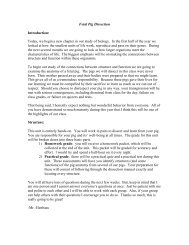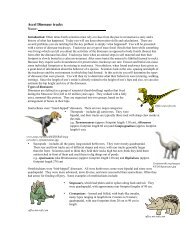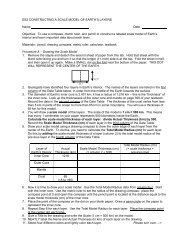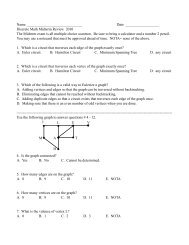KEPLER'S LAWS OF PLANETARY MOTION NAME ... - LS Home Page
KEPLER'S LAWS OF PLANETARY MOTION NAME ... - LS Home Page
KEPLER'S LAWS OF PLANETARY MOTION NAME ... - LS Home Page
You also want an ePaper? Increase the reach of your titles
YUMPU automatically turns print PDFs into web optimized ePapers that Google loves.
KEPLER’S <strong>LAWS</strong> <strong>OF</strong> <strong>PLANETARY</strong> <strong>MOTION</strong><strong>NAME</strong>: __________________________________Date: _______________Purpose: To understand Kepler’s Laws describing the movements of planets in the solar system.Background: In the 1500s, Nicolaus Copernicus challenged the GEOCENTRIC (earth-centered)model of the solar system that had been promoted and accepted by philosophers and astronomerssuch as Aristotle and Ptolemy for almost 2000 years. Copernicus described a HELIOCENTRIC(sun-centered) model of the solar system, which placed Earth and the other planets in circularorbits around the Sun. He proposed that all planets orbit in the same direction, but each planetorbits at a different speed and distance from the Sun. Galileo’s observations made with histelescope in the early 1600s and the work of other astronomers eventually confirmedCopernicus’ model.Tycho Brahe, a 16 th Century Danish astronomer, spent his life making detailed, preciseobservations of the positions of stars and planets. His apprentice, Johannes Kepler, explainedBrahe’s observations in mathematical terms and developed three laws of planetary motion.Kepler’s laws, together with Newton’s Laws of Inertia and Universal Gravitation, explain mostplanetary motion.KEPLER’S FIRST LAWKepler’s First Law, the “Law of Ellipses” states that all objects that orbit the Sun, includingplanets, asteroids and comets, follow elliptical paths. An ellipse is an oval-shaped geometricfigure whose shape is determined by two points within the figure. Each point is called a “focus”(plural: foci). In the solar system, the Sun is at one focus of the orbit of each planet; the secondfocus is empty.Use the tacks and thread provided to draw an ellipse in the space below. Place the tacks 2 cmapart near the middle of the paper. The tacks represent the foci of the ellipse.
LABEL and measure the following on the ellipse diagram on the front of this page.1. Label one focus “SUN”. Leave the other focus blank.2. Label the ellipse “Planet’s Orbit”.3. Measure the distance F between the foci (the holes made by the tacks) to the nearest tenthof a centimeter: distance F = __________4. Use a ruler to draw a line that passes through the two foci and extends to both sides of theellipse. This is the “major axis” (A) of the ellipse. Measure the length of the major axis tothe nearest tenth of a centimeter: A = __________5. ECCENTRICITY is the amount of flattening of an ellipse, or how much the shape of theellipse deviates from a perfect circle. A circle, which has only one central focus) has aneccentricity of 0. The greater the eccentricity, the less circular the ellipse.Calculate the eccentricity of the ellipse drawn on the front of the page by substituting themeasured values of F and A into the following equation. Show your work in the boxprovided.Eccentricity (e) = F ÷ A6. Look at the Planet Data Table in your notes.Which planet has the most elliptical orbit? ______________________________Which planet has the most circular orbit? ______________________________7. Because a planet’s orbit is elliptical, its distance from the Sun varies throughout its “year”(one revolution around the Sun). Look up the following terms in your textbook (p. 29 ofblue textbooks in the room or p.668 yellow textbook) and write their definitions in thespaces provided.PERIHELIONAPHELIONLABEL the points that represent perihelion and aphelion on the ellipse diagram on thefront of this page.8. Look up the following information in your textbook and fill in the blanks.Earth is at perihelion on _________________________; on that date, Earth isapproximately _________________________ km from the Sun.Earth is at aphelion on _________________________; on that date, Earth is approximately_________________________ km from the Sun.9. Based on your understanding of Kepler’s First Law, explain why the distance from a planetto the Sun is typically given as an average distance.KEPLER’S SECOND LAWKepler’s Second Law, the “Law of Equal Areas” states that a line drawn from the Sun to a planetsweeps equal areas in equal time, as illustrated on the diagram on the next page. A planet’sorbital velocity (the speed at which it travels around the Sun) changes as its position in its orbitchanges. Its velocity is fastest when it is closest to the Sun and slowest when it is farthest fromthe sun.
13. Calculate the period of revolution of each of the following planets.Planet Mean Distance to Sun (AU) Period of Revolution (Earth years)Mercury 0.387Mars 1.524Saturn 9.539Pluto 39.44014. Haley’s comet has an average distance of 17.91 AU from the Sun. Calculate the periodof Haley’s comet.15. Draw a graph that shows the relationship between a planet’s period of revolution (inEarth years) and its average distance from the Sun (in AU). Look up the data on thePlanet Data Table in your notes. Plot period on the x-axis and distance on the y-axis.Label each planet on the graph. Be sure to label the axes and include a title.Describe the graph. What is the relationship between period and distance from the Sun?



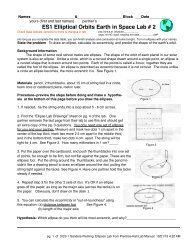


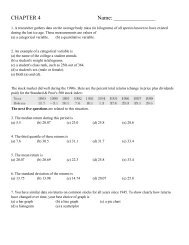


![';1asAu ro; las I sgeo8 leuo!]eslanuol aql utelqo o1 palenttouJ ue I ...](https://img.yumpu.com/49072782/1/190x221/1asau-ro-las-i-sgeo8-leuoeslanuol-aql-utelqo-o1-palenttouj-ue-i-.jpg?quality=85)

